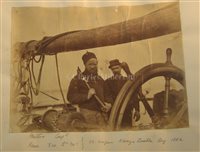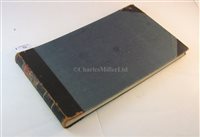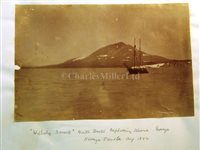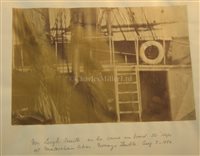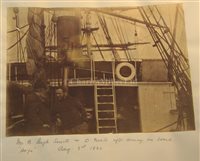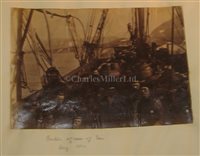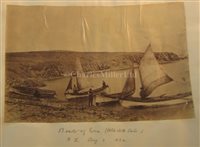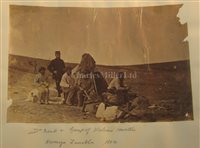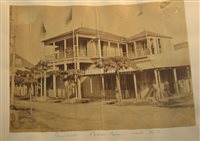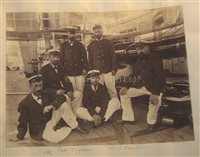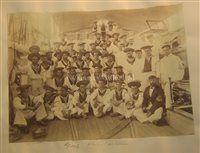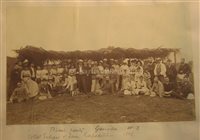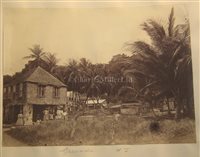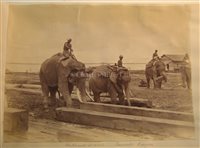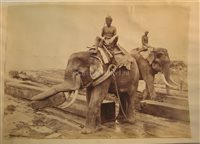30th Apr, 2014 12:00
Maritime and Scientific Models, Instruments & Art (Seraph)
72
[M] BENJAMIN LEIGH SMITH: A QUANTITY OF EARLY...
comprising eight 5 x 7½in. sepia prints secured to annotated album leaves and including a view of the Dutch arctic exploration schooner Wilhelm Barents; views of Smith and the crew aboard the Eira and Hope; landing party views of Eira's boats with 'table cloth sails'; together with a further nine images from the West Indies and views aboard H.M.S. Fantome, laid to paper pages within an unused accounts book for 1885-6 -- 9 x 14¾in. (23 x 37.5cm.)
Benjamin Leigh-Smith (1828-1913) born to wealthy non-conformist parents, he trained as a lawyer but was wealthy enough to indulge his fascination with the Arctic. In 1880 Smith built the auxiliary brigantine Eira in which he sailed from Peterhead, but because of mist and pack ice failed to make Jan Mayen or east Greenland. Learning that ice on the north coast of Spitsbergen made it impossible to pass Amsterdam Island, he made for Franz Josef Land, recently discovered (in 1873-4) and only partly mapped. He reached and named May Island in August, adding the south-west coast of the new land to the chart. He also made some additions to the chart of the east coast of Spitsbergen. For these discoveries he was awarded the Patron's Medal of the Royal Geographical Society in 1881. His paper on the voyage of 1880 was read at a meeting of the society and its importance agreed. In 1881 the Eira sailed from Peterhead and sighted Novaya Zemlya and Franz Josef Land, but on 21 August the yacht was nipped between pack ice and land floe off Cape Flora, and sank within two hours. The crew lived in a makeshift hut, built from materials they had previously deposited on Bell Island, for ten months, before taking to their boats in June 1882 for the homeward passage. They reached Novaya Zemlya where they met the Hope, commanded by Sir Allen W. Young, who had been sent to find them following considerable speculation in England as to their whereabouts. The whole crew landed safely at Aberdeen at the end of August 1882, having survived the winter because lack of provisions led them to live on a much healthier diet of fresh meat, and because of Smith's quiet leadership. Back in England, Smith gave £1000 to the Royal Geographical Society in gratitude for the mounting of the search party. In 1882 he was made an honorary fellow of Jesus College, Cambridge. He made no further Arctic expeditions, and revoked the bequest of £80,000 he had left to the Royal Geographical Society in 1887, in frustration at their neglect of polar exploration. Nonetheless, in 1892 he worked with the Society to promote scientific investigation of the Antarctic.
Sold for £2,728
Estimated at £400 - £600
(inc. buyer's premium of 24%)
Condition Report
Some fading/spotting and creasing.
We are pleased to provide you with a general report of the condition of this property. Since we are not professional conservators or restorers, we urge you to consult with a restorer or conservator of your choice who will be better able to provide a detailed, professional report. Prospective buyers should inspect each lot to satisfy themselves as to condition and must understand that any statement made by Charles Miller Ltd is merely a subjective, qualified opinion. Prospective buyers should also refer to any Important Notices regarding this sale, which are printed in the Sale Catalogue. NOTWITHSTANDING THIS REPORT OR ANY DISCUSSIONS CONCERNING A LOT, ALL LOTS ARE OFFERED AND SOLD “AS IS” IN ACCORDANCE WITH THE CONDITIONS OF BUSINESS PRINTED IN THE SALE CATALOGUE.
comprising eight 5 x 7½in. sepia prints secured to annotated album leaves and including a view of the Dutch arctic exploration schooner Wilhelm Barents; views of Smith and the crew aboard the Eira and Hope; landing party views of Eira's boats with 'table cloth sails'; together with a further nine images from the West Indies and views aboard H.M.S. Fantome, laid to paper pages within an unused accounts book for 1885-6 -- 9 x 14¾in. (23 x 37.5cm.)
Benjamin Leigh-Smith (1828-1913) born to wealthy non-conformist parents, he trained as a lawyer but was wealthy enough to indulge his fascination with the Arctic. In 1880 Smith built the auxiliary brigantine Eira in which he sailed from Peterhead, but because of mist and pack ice failed to make Jan Mayen or east Greenland. Learning that ice on the north coast of Spitsbergen made it impossible to pass Amsterdam Island, he made for Franz Josef Land, recently discovered (in 1873-4) and only partly mapped. He reached and named May Island in August, adding the south-west coast of the new land to the chart. He also made some additions to the chart of the east coast of Spitsbergen. For these discoveries he was awarded the Patron's Medal of the Royal Geographical Society in 1881. His paper on the voyage of 1880 was read at a meeting of the society and its importance agreed. In 1881 the Eira sailed from Peterhead and sighted Novaya Zemlya and Franz Josef Land, but on 21 August the yacht was nipped between pack ice and land floe off Cape Flora, and sank within two hours. The crew lived in a makeshift hut, built from materials they had previously deposited on Bell Island, for ten months, before taking to their boats in June 1882 for the homeward passage. They reached Novaya Zemlya where they met the Hope, commanded by Sir Allen W. Young, who had been sent to find them following considerable speculation in England as to their whereabouts. The whole crew landed safely at Aberdeen at the end of August 1882, having survived the winter because lack of provisions led them to live on a much healthier diet of fresh meat, and because of Smith's quiet leadership. Back in England, Smith gave £1000 to the Royal Geographical Society in gratitude for the mounting of the search party. In 1882 he was made an honorary fellow of Jesus College, Cambridge. He made no further Arctic expeditions, and revoked the bequest of £80,000 he had left to the Royal Geographical Society in 1887, in frustration at their neglect of polar exploration. Nonetheless, in 1892 he worked with the Society to promote scientific investigation of the Antarctic.
Auction: Maritime and Scientific Models, Instruments & Art (Seraph), 30th Apr, 2014


